
Featured Breeder
Kiichi Hoshino(Teradomari Koi Farm) |
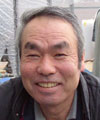 |
After becoming the Division Champion at the 30th All Japan Combined Nishikigoi Show in 1998, Teradomari Koi Farm’s Ginrin Kohaku is now called the “Teradomari Ginrin” and is beloved by Koi lovers all over the world. Family head Mr. Kiichi Hoshino currently focuses on body conformation and quality of the gin scales of his Teradomari Ginrin and is aiming to become the first non-Kohaku/Gosanke Grand Champion at the Show.
|
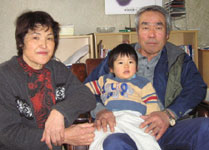 In the early 1960s at the age of eighteen, I got involved in the Nishikigoi business to earn extra money. At the time, I worked at a steel factory on weekdays and helped a Nishikigoi business (Miyakoya) in Ojiya City on my day-offs. My daily pay was one thousand Koi fry. I kept them in mud ponds, and kept raising them and selling them. That’s how it all began. Perhaps because of the Nishikigoi boom, I earned more by selling Nishikigoi on the side than by my day job. I got seriously involved in the Nishikigoi business when I was put in charge to manage mud ponds after starting to work at Hoshikin Koi Farm. In 1967, when I was 24 years old, I wed the daughter of Hoshikin Koi Farm. I moved to Teradomari to take over a pond they owned in that area and helped the production as a breeder until I became independent in 1979. I ran an unknown Koi farm for a long time, but in 1990 I hung out a sign as the current Teradomari Koi Farm. I mainly produced Kohaku (of Hoshikin lineage) back then, but after winning the Division Champion at The All Japan Combined Young Nishikigoi Show in 1995, I changed course to Daiya Ginrin. Now it accounts for about 70% of the production. In the early 1960s at the age of eighteen, I got involved in the Nishikigoi business to earn extra money. At the time, I worked at a steel factory on weekdays and helped a Nishikigoi business (Miyakoya) in Ojiya City on my day-offs. My daily pay was one thousand Koi fry. I kept them in mud ponds, and kept raising them and selling them. That’s how it all began. Perhaps because of the Nishikigoi boom, I earned more by selling Nishikigoi on the side than by my day job. I got seriously involved in the Nishikigoi business when I was put in charge to manage mud ponds after starting to work at Hoshikin Koi Farm. In 1967, when I was 24 years old, I wed the daughter of Hoshikin Koi Farm. I moved to Teradomari to take over a pond they owned in that area and helped the production as a breeder until I became independent in 1979. I ran an unknown Koi farm for a long time, but in 1990 I hung out a sign as the current Teradomari Koi Farm. I mainly produced Kohaku (of Hoshikin lineage) back then, but after winning the Division Champion at The All Japan Combined Young Nishikigoi Show in 1995, I changed course to Daiya Ginrin. Now it accounts for about 70% of the production.
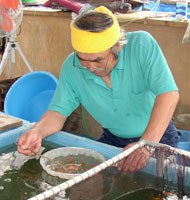 The roots of “Teradomari Ginrin” is the Hoshikin female Kohaku and the Suda male Ginrin. Since most of the production was Kohaku in 1992, Ginrin Kohaku was very few in number, but luckily one of them won the Division Champion. The characteristic of “Teradomari Ginrin” is that the gin does not fade away as it grows. A normal Daiya Ginrin will lose its gin color when it becomes about 70 cm (28 inches), but as our Daiya Ginrin grows older, the gin alignment improves, and the glitter stays. That’s its uniqueness. None the less, the most important element in a Koi is body conformation, so it needs to be large in size. The alignment and appearance of gin, the quality and patterns of hi are all very important, but what relieves and soothes us is the leisurely and vigorous swim of a big Koi. The roots of “Teradomari Ginrin” is the Hoshikin female Kohaku and the Suda male Ginrin. Since most of the production was Kohaku in 1992, Ginrin Kohaku was very few in number, but luckily one of them won the Division Champion. The characteristic of “Teradomari Ginrin” is that the gin does not fade away as it grows. A normal Daiya Ginrin will lose its gin color when it becomes about 70 cm (28 inches), but as our Daiya Ginrin grows older, the gin alignment improves, and the glitter stays. That’s its uniqueness. None the less, the most important element in a Koi is body conformation, so it needs to be large in size. The alignment and appearance of gin, the quality and patterns of hi are all very important, but what relieves and soothes us is the leisurely and vigorous swim of a big Koi.
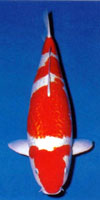 Nowadays breeding techniques and environment have progressed, and there are too many well-looking Koi from an early stage. I hardly ever see a bad Tosai or Nisai that may become wonderful depending on how they are raised. It’s a real shame that there are few Koi that can dramatically change like before. I say this because my “Masked Ginrin Kohaku,” which won the 75th Kin Gin Division Champion at The 31st Yurinkai Nishikigoi Show in 2000, used to be a yellow Koi with faded Kiwa and bad patterns. The only good thing about it was body conformation. Nobody even looked at it back then. When releasing the Koi into field ponds, my friends made fun of me for putting “such a bad Koi in such a good pond.” But I raised it because “I knew this Koi will become good.” And as a result, it became a Champion Koi. A breeder could never forget such joy. Nowadays breeding techniques and environment have progressed, and there are too many well-looking Koi from an early stage. I hardly ever see a bad Tosai or Nisai that may become wonderful depending on how they are raised. It’s a real shame that there are few Koi that can dramatically change like before. I say this because my “Masked Ginrin Kohaku,” which won the 75th Kin Gin Division Champion at The 31st Yurinkai Nishikigoi Show in 2000, used to be a yellow Koi with faded Kiwa and bad patterns. The only good thing about it was body conformation. Nobody even looked at it back then. When releasing the Koi into field ponds, my friends made fun of me for putting “such a bad Koi in such a good pond.” But I raised it because “I knew this Koi will become good.” And as a result, it became a Champion Koi. A breeder could never forget such joy.
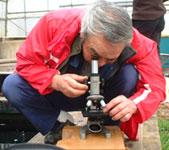 My present goal is to produce a Daiya Ginrin that can top its oyagoi. All breeders want to catch up to and pass Koi of their previous generations. I would like to produce an old-time Daiya Ginrin which has five or six “gin” on the scales; one that glitters differently depending on the angle, just like a diamond. And of course, with good body conformation. Recent trends are fully gin scales, precisely why I am set out to produce glittering Daiya Ginrin that my predecessors used to make. It is usually difficult to win Grand Champion with a Ginrin, but perhaps there is a chance if it grows to be over 85cm (34 inches). My present goal is to produce a Daiya Ginrin that can top its oyagoi. All breeders want to catch up to and pass Koi of their previous generations. I would like to produce an old-time Daiya Ginrin which has five or six “gin” on the scales; one that glitters differently depending on the angle, just like a diamond. And of course, with good body conformation. Recent trends are fully gin scales, precisely why I am set out to produce glittering Daiya Ginrin that my predecessors used to make. It is usually difficult to win Grand Champion with a Ginrin, but perhaps there is a chance if it grows to be over 85cm (34 inches).
It is wonderful that Japan’s national fish, Nishikigoi, has become known in the world. I would like for Koi lovers to spend a lot of time in taking care of their Koi. I couldn’t give advices on how to raise a Koi because every Koi lover’s pond and breeding environment are different. All I can say is to love your Koi just as loving a pet and to raise it into a beautiful Nishikigoi. Compared to other varieties, because of the appearance of gin, the skin of Daiya Ginrin is very sensitive. Please take time and give it a lot of attention. I hope your Daiya Ginrin becomes your pride and joy.
|
|

 In the early 1960s at the age of eighteen, I got involved in the Nishikigoi business to earn extra money. At the time, I worked at a steel factory on weekdays and helped a Nishikigoi business (Miyakoya) in Ojiya City on my day-offs. My daily pay was one thousand Koi fry. I kept them in mud ponds, and kept raising them and selling them. That’s how it all began. Perhaps because of the Nishikigoi boom, I earned more by selling Nishikigoi on the side than by my day job. I got seriously involved in the Nishikigoi business when I was put in charge to manage mud ponds after starting to work at Hoshikin Koi Farm. In 1967, when I was 24 years old, I wed the daughter of Hoshikin Koi Farm. I moved to Teradomari to take over a pond they owned in that area and helped the production as a breeder until I became independent in 1979. I ran an unknown Koi farm for a long time, but in 1990 I hung out a sign as the current Teradomari Koi Farm. I mainly produced Kohaku (of Hoshikin lineage) back then, but after winning the Division Champion at The All Japan Combined Young Nishikigoi Show in 1995, I changed course to Daiya Ginrin. Now it accounts for about 70% of the production.
In the early 1960s at the age of eighteen, I got involved in the Nishikigoi business to earn extra money. At the time, I worked at a steel factory on weekdays and helped a Nishikigoi business (Miyakoya) in Ojiya City on my day-offs. My daily pay was one thousand Koi fry. I kept them in mud ponds, and kept raising them and selling them. That’s how it all began. Perhaps because of the Nishikigoi boom, I earned more by selling Nishikigoi on the side than by my day job. I got seriously involved in the Nishikigoi business when I was put in charge to manage mud ponds after starting to work at Hoshikin Koi Farm. In 1967, when I was 24 years old, I wed the daughter of Hoshikin Koi Farm. I moved to Teradomari to take over a pond they owned in that area and helped the production as a breeder until I became independent in 1979. I ran an unknown Koi farm for a long time, but in 1990 I hung out a sign as the current Teradomari Koi Farm. I mainly produced Kohaku (of Hoshikin lineage) back then, but after winning the Division Champion at The All Japan Combined Young Nishikigoi Show in 1995, I changed course to Daiya Ginrin. Now it accounts for about 70% of the production.


 The roots of “Teradomari Ginrin” is the Hoshikin female Kohaku and the Suda male Ginrin. Since most of the production was Kohaku in 1992, Ginrin Kohaku was very few in number, but luckily one of them won the Division Champion. The characteristic of “Teradomari Ginrin” is that the gin does not fade away as it grows. A normal Daiya Ginrin will lose its gin color when it becomes about 70 cm (28 inches), but as our Daiya Ginrin grows older, the gin alignment improves, and the glitter stays. That’s its uniqueness. None the less, the most important element in a Koi is body conformation, so it needs to be large in size. The alignment and appearance of gin, the quality and patterns of hi are all very important, but what relieves and soothes us is the leisurely and vigorous swim of a big Koi.
The roots of “Teradomari Ginrin” is the Hoshikin female Kohaku and the Suda male Ginrin. Since most of the production was Kohaku in 1992, Ginrin Kohaku was very few in number, but luckily one of them won the Division Champion. The characteristic of “Teradomari Ginrin” is that the gin does not fade away as it grows. A normal Daiya Ginrin will lose its gin color when it becomes about 70 cm (28 inches), but as our Daiya Ginrin grows older, the gin alignment improves, and the glitter stays. That’s its uniqueness. None the less, the most important element in a Koi is body conformation, so it needs to be large in size. The alignment and appearance of gin, the quality and patterns of hi are all very important, but what relieves and soothes us is the leisurely and vigorous swim of a big Koi.  Nowadays breeding techniques and environment have progressed, and there are too many well-looking Koi from an early stage. I hardly ever see a bad Tosai or Nisai that may become wonderful depending on how they are raised. It’s a real shame that there are few Koi that can dramatically change like before. I say this because my “Masked Ginrin Kohaku,” which won the 75th Kin Gin Division Champion at The 31st Yurinkai Nishikigoi Show in 2000, used to be a yellow Koi with faded Kiwa and bad patterns. The only good thing about it was body conformation. Nobody even looked at it back then. When releasing the Koi into field ponds, my friends made fun of me for putting “such a bad Koi in such a good pond.” But I raised it because “I knew this Koi will become good.” And as a result, it became a Champion Koi. A breeder could never forget such joy.
Nowadays breeding techniques and environment have progressed, and there are too many well-looking Koi from an early stage. I hardly ever see a bad Tosai or Nisai that may become wonderful depending on how they are raised. It’s a real shame that there are few Koi that can dramatically change like before. I say this because my “Masked Ginrin Kohaku,” which won the 75th Kin Gin Division Champion at The 31st Yurinkai Nishikigoi Show in 2000, used to be a yellow Koi with faded Kiwa and bad patterns. The only good thing about it was body conformation. Nobody even looked at it back then. When releasing the Koi into field ponds, my friends made fun of me for putting “such a bad Koi in such a good pond.” But I raised it because “I knew this Koi will become good.” And as a result, it became a Champion Koi. A breeder could never forget such joy.  My present goal is to produce a Daiya Ginrin that can top its oyagoi. All breeders want to catch up to and pass Koi of their previous generations. I would like to produce an old-time Daiya Ginrin which has five or six “gin” on the scales; one that glitters differently depending on the angle, just like a diamond. And of course, with good body conformation. Recent trends are fully gin scales, precisely why I am set out to produce glittering Daiya Ginrin that my predecessors used to make. It is usually difficult to win Grand Champion with a Ginrin, but perhaps there is a chance if it grows to be over 85cm (34 inches).
My present goal is to produce a Daiya Ginrin that can top its oyagoi. All breeders want to catch up to and pass Koi of their previous generations. I would like to produce an old-time Daiya Ginrin which has five or six “gin” on the scales; one that glitters differently depending on the angle, just like a diamond. And of course, with good body conformation. Recent trends are fully gin scales, precisely why I am set out to produce glittering Daiya Ginrin that my predecessors used to make. It is usually difficult to win Grand Champion with a Ginrin, but perhaps there is a chance if it grows to be over 85cm (34 inches).